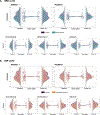Subfield-specific longitudinal changes of hippocampal volumes in patients with early-stage bipolar disorder
- PMID: 36855850
- PMCID: PMC10330583
- DOI: 10.1111/bdi.13315
Subfield-specific longitudinal changes of hippocampal volumes in patients with early-stage bipolar disorder
Abstract
Background: The hippocampus is a heterogeneous structure composed of biologically and functionally distinct subfields. Hippocampal aberrations are proposed to play a fundamental role in the etiology of psychotic symptoms. Bipolar disorder (BPD) has substantial overlap in symptomatology and genetic liability with schizophrenia (SZ), and reduced hippocampal volumes, particularly at the chronic illness stages, are documented in both disorders. Studies of hippocampal subfields in the early stage of BPD are limited and cross-sectional findings to date report no reduction in hippocampal volumes. To our knowledge, there have been no longitudinal studies of BPD evaluating hippocampal volumes in the early phase of illness. We investigated the longitudinal changes in hippocampal regions and subfields in BPD mainly and in early stage of psychosis (ESP) patients more broadly and compared them to those in controls (HC).
Methods: Baseline clinical and structural MRI data were acquired from 88 BPD, from a total of 143 ESP patients, and 74 HCs. Of those, 66 participants (23 HC, 43 patients) completed a 12-month follow-up visit. The hippocampus regions and subfields were segmented using Freesurfer automated pipeline.
Results: We found general baseline deficits in hippocampal volumes among BPD and ESP cohorts. Both cohorts displayed significant increases in the anterior hippocampal region and dentate gyrus compared with controls. Additionally, antipsychotic medications were positively correlated with the posterior region at baseline.
Conclusion: These findings highlight brain plasticity in BPD and in ESP patients providing evidence that deviations in hippocampal volumes are adaptive responses to atypical signaling rather than progressive degeneration.
Keywords: bipolar disorder; early-stage psychosis; hippocampus subfield volumes; longitudinal.
© 2023 John Wiley & Sons A/S. Published by John Wiley & Sons Ltd.
Conflict of interest statement
Conflict of Interest
The authors have declared that there are no conflicts of interest in relation to the subject of this study.
Figures


Similar articles
-
In vivo hippocampal subfield volumes in schizophrenia and bipolar disorder.Biol Psychiatry. 2015 Mar 15;77(6):581-8. doi: 10.1016/j.biopsych.2014.06.020. Epub 2014 Jul 3. Biol Psychiatry. 2015. PMID: 25127742
-
Medial temporal lobe structures and hippocampal subfields in psychotic disorders: findings from the Bipolar-Schizophrenia Network on Intermediate Phenotypes (B-SNIP) study.JAMA Psychiatry. 2014 Jul 1;71(7):769-77. doi: 10.1001/jamapsychiatry.2014.453. JAMA Psychiatry. 2014. PMID: 24828364
-
Hippocampal and amygdala volumes according to psychosis stage and diagnosis: a magnetic resonance imaging study of chronic schizophrenia, first-episode psychosis, and ultra-high-risk individuals.Arch Gen Psychiatry. 2006 Feb;63(2):139-49. doi: 10.1001/archpsyc.63.2.139. Arch Gen Psychiatry. 2006. PMID: 16461856
-
FreeSurfer-based segmentation of hippocampal subfields: A review of methods and applications, with a novel quality control procedure for ENIGMA studies and other collaborative efforts.Hum Brain Mapp. 2022 Jan;43(1):207-233. doi: 10.1002/hbm.25326. Epub 2020 Dec 27. Hum Brain Mapp. 2022. PMID: 33368865 Free PMC article. Review.
-
Psychosocial factors and hippocampal subfields: The Medea-7T study.Hum Brain Mapp. 2023 Apr 1;44(5):1964-1984. doi: 10.1002/hbm.26185. Epub 2022 Dec 30. Hum Brain Mapp. 2023. PMID: 36583397 Free PMC article.
Cited by
-
Plastic but not progressive changes in cognitive function and hippocampal volume in an adolescent with bipolar disorder: a case report.Front Psychiatry. 2025 Jan 7;15:1507333. doi: 10.3389/fpsyt.2024.1507333. eCollection 2024. Front Psychiatry. 2025. PMID: 39839126 Free PMC article.
-
Exposotypes in psychotic disorders.Sci Rep. 2025 Aug 8;15(1):29003. doi: 10.1038/s41598-025-14438-6. Sci Rep. 2025. PMID: 40781464 Free PMC article.
-
Hippocampal subfield morphology from first episodes of bipolar disorder type II and major depressive disorder in a drug naïve Chinese cohort.Front Psychiatry. 2024 Jul 25;15:1438144. doi: 10.3389/fpsyt.2024.1438144. eCollection 2024. Front Psychiatry. 2024. PMID: 39119073 Free PMC article.

